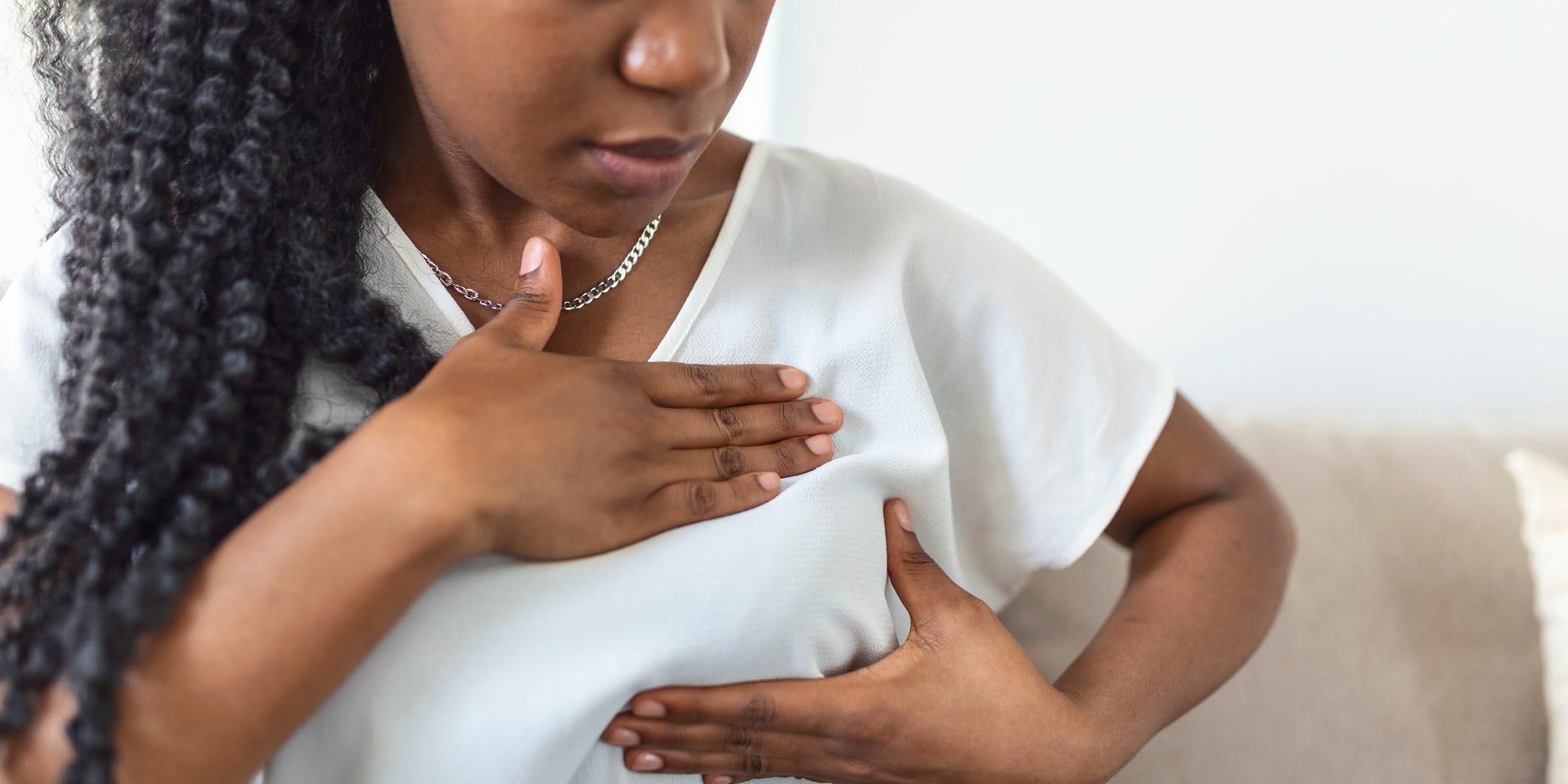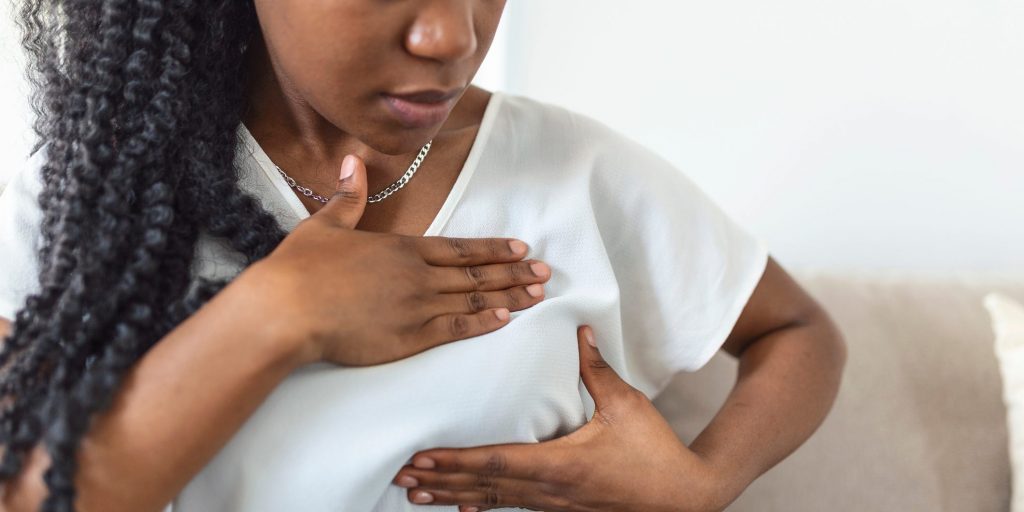
stefanamer/Getty Images
- Inflammatory breast cancer is an aggressive form of breast cancer usually diagnosed in later stages.
- It usually occurs in women under age 40 where the breast swells rapidly over just a few weeks.
- Chemotherapy is the leading form of treatment for inflammatory breast cancer.
- Visit Insider's Health Reference library for more advice.
Inflammatory breast cancer (IBC) differs from other types of breast cancer in symptoms, outlook, and treatment.
It often occurs in younger women under the age of 40, it's more aggressive, and is diagnosed in later stages.
However, it's also more rare, only accounting for about 1% to 5% of all breast cancer cases in the U.S.
Below is an in-depth guide on how to spot the signs of IBC, as well as how it's diagnosed and treated.
Inflammatory breast cancer symptoms
Unlike most forms of breast cancer, IBC doesn't cause a distinct breast lump. Instead, the first sign is usually breast swelling and reddening that rapidly gets worse over just a few weeks, according to Mehra Golshan, MD, clinical director of the Breast Program at Yale Cancer Center and Smilow Cancer Hospital.
Since IBC can start with a minor skin irritation including redness, itchiness, swelling, and ridges in the skin, some people may mistake it for a skin rash, hives, or bug bites.
It becomes easier to distinguish IBC from a rash or insect bite when these symptoms don't improve and begin to coincide with other symptoms including:
- Redness covering more than one-third of the breast
- Purplish discoloration that looks like bruising
- Dimpling of the breast skin, which is often compared to the texture of an orange peel
- Skin thickening on the breast
- Rapidly increasing breast size and/or heaviness
- Breast tenderness, aching, itchiness, or general pain
- Enlarged lymph nodes around the collarbone or under the arm
- An inverted or flattened nipple
- An unusual sensation of warmth in the breast
These symptoms of inflammatory breast cancer will typically develop within three to six months, and worsen within just several weeks to several months, says Golshan. Almost all IBC patients experience enlarged lymph nodes, according to Golshan.
Diagnosis
Park says that you should see your primary care physician for a possible IBC diagnosis if you experience any of the following signs and symptoms:
- Skin changes in the breast like redness, swelling, and/or thickening
- An enlarging breast mass or masses
- Swollen lymph nodes in the armpit
After giving your doctor a detailed history of the symptoms you're experiencing, they'll examine your breasts and lymph nodes. If they suspect IBC, they'll likely perform a breast imaging test.
One of the most common imaging tests used to diagnose IBC is a mammogram, which provides X-ray images that may show suspicious masses and other breast changes.
Your doctor may choose to pair the mammogram with an ultrasound for clearer results. While a mammogram alone has about a 68% detection rate for IBC, that rate surges to 98% to 100% when it's combined with an ultrasound.
That's because an ultrasound produces images of the inside of the breast using sound waves and may identify changes that are undetectable with a mammogram.
An MRI may also be recommended if your doctor needs more information about a suspicious result on your mammogram or ultrasound.
If the imaging tests indicate something unusual, your doctor will likely order a breast biopsy to confirm a diagnosis. During the biopsy, you'll usually be under local anesthesia while the doctor removes a small sample of tissue for lab testing.
Once an IBC diagnosis is made, your doctor will order staging tests.
If the IBC is stage IV it means the cancer has spread to other organs such as the bones, lungs, or liver. This type of spread is present in about one out of every three people diagnosed with IBC.
Staging tests may include any of the following:
- Chest X-ray
- Computerized tomography (CT) scan of the chest, pelvis, and abdomen
- Bone scan
- Liver function tests
A newer, more expensive test that's becoming increasingly popular is the PET/CT scan, which can examine cancer on a cellular level. This test is usually done to determine whether there are cancer cells in other areas of the body like the brain, bones, or lungs. Researchers say it can be useful in the staging process because it can provide info on the primary location of the cancer, where the disease is involved throughout the rest of the body, and how aggressive it is.
Treatment
Treatment for IBC takes about six months to a year, according to Golshan.
Typically, IBC is treated first with chemotherapy, which involves taking drugs aimed at shrinking the tumor. How often you get chemotherapy will depend largely on how advanced your cancer is, but typically, patients receive treatment in cycles followed by a period of rest. For example, you might have chemotherapy every day for a week, and then take three weeks off before repeating the cycle.
Chemo drugs can be administered intravenously, via injections, or orally, and are used to kill off cancer cells in the breast as well as other parts of the body it may have spread to.
As long as the cancer has responded positively to chemo, surgery is the next step. This often involves removing the entire affected breast, a procedure known as a mastectomy, and the nearby lymph nodes under the arm.
After surgery, the final step may be radiation therapy, which uses high-powered beams of energy aimed at the chest and armpit area to destroy any remaining cancer cells. Hormone therapy may also be used after surgery or radiation therapy to try and prevent the cancer from coming back.
Recurrence
Breast cancer is most likely to come back in the first three to five years following treatment.
Moreover, risk of recurrence can largely depend on whether, or not, the cancer was present in your lymph nodes at the time of treatment:
- If lymph nodes were cancer-free: There is about a 6% chance of recurrence in the first five years after a mastectomy.
- If lymph nodes had cancer: There is about a 23% chance of recurrence in the first five years after a mastectomy. However, getting radiation therapy can reduce that chance to 6%.
Survival rate
The five-year survival rate for IBC is around 40% - but it's important to note there are multiple factors that can affect someone's outlook, including their overall health, how early they were diagnosed and treatment was first administered, and how much the cancer has spread.
For example, a 2014 study found that five- and 10-year survival rates were higher among patients who received a combination of chemotherapy, surgery, and radiation compared to those who only had one or two of these treatment types.
Research has also shown there's been a significant improvement in survival rates for IBC patients over the last two decades. In fact, a 2020 study found people with this condition are living about twice as long after diagnosis than they were in the 1970s.
Cost and financial assistance
The cost of treatment varies depending on the type of treatment and stage of the cancer but can range from $60,637 to $134,682 in the first year after diagnosis.
If you're struggling to cover the cost of treatment, Golshan recommends looking into organizations that offer financial assistance, such as:
- CancerCare Co-Payment Assistance Foundation
- Susan G Komen Treatment Assistance Program
- The Pink Fund
Most hospitals and healthcare facilities have financial counselors who can work out a payment plan with you and direct you to assistance programs.
Additionally, some pharmaceutical companies have set up special funds that cover all or part of the cost of their cancer medicines.
Insider's takeaway
If you notice that your breast is red or purple, itchy, dimply, and/or swelling at a rapid rate it could be a sign of IBC. But remember, this form of cancer is rare, affecting only 1% to 5% of breast cancer patients.
And just because you have any of the above symptoms doesn't necessarily mean you have IBC. Therefore, it's important that you see a doctor as soon as possible, especially if you meet any of the risk factors.
As with other forms of breast cancer, early detection plays a key role in the prognosis. Treatments are continually improving for this rare but aggressive form of breast cancer - and taking advantage of multiple treatments tends to increase your odds of beating it.
Many IBC patients find it helpful to participate in support groups. The IBC Network Online Community was established specifically for people with inflammatory breast cancer, but you can also contact the Komen Breast Care Helpline 1-877 GO KOMEN (1-877-465-6636) to find additional local or virtual support programs.
